Shore Fishing For Salmon: Tips From Experts
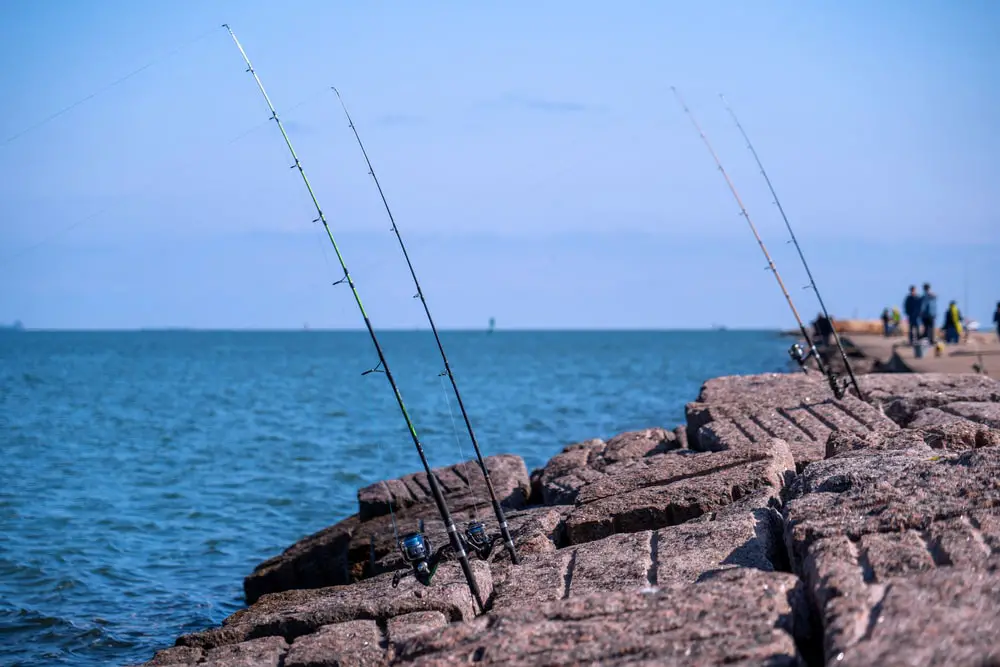
If you’re an angler who loves the thrill of fishing but doesn’t have access to a boat, worry not! Shore fishing for salmon is a fantastic way to catch these prized fish, and I’ll explain how and why. Some anglers also refer to it as surf fishing for salmon or beach fishing for salmon, but essentially, they are the same.
In this article, I’ll cover the essentials of targeting Pacific salmon from the shore with tips and advice from guides and good local anglers. Whether you’re a newcomer or an intermediate fisherman, you can learn the techniques, tackle, and timing required to increase your chances of successfully catching salmon from shore. Let’s dive in!
Targeting Pacific Salmon From The Shore
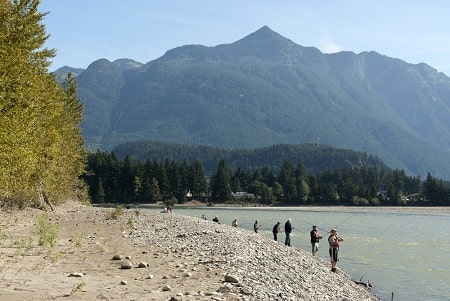
Shore fishing provides an excellent opportunity to catch all species of Pacific salmon. However, pink salmon and coho salmon are often the most available from shore.
Occasionally, you may also find large Chinook salmon and chum salmon near the shore as they search for their spawning rivers.
As these salmon near the end of their adult life in the ocean, they become aggressive feeders along shorelines where food is abundant. Their diet includes herring, anchovy, needlefish, sandlance, stickleback, shrimp, and crab larvae.
Since these salmon are always hungry, enticing them with your lure or fly shouldn’t be too difficult. There’s a very good chance if you can get your lure close enough to t salmon they will hit it.
However, there might be times when they seem less interested in biting. In such cases, it’s crucial to figure out their current food preference. With such a wide range of prey available, matching your lure or fly to their preferred food source can significantly improve your success.
Choosing the Right Fishing Tackle
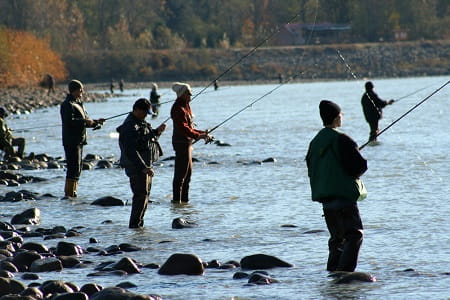
For shore fishing for salmon, two primary techniques are popular: spincasting and fly fishing. The key to success is achieving a good casting distance since fish often feed far from the shore.
A fishing rod measuring at least 9 feet long is recommended, and it should have a rating of at least 8lb to 14lb test. The rod should also be capable of handling lures weighing up to 1/2oz.
As for the reel, opt for a spinning or baitcasting reel with a spool capacity of at least 8lb test monofilament line. A reel size 3000 to 4000 (30 or 40) is ideal for most fish encountered in this fishery.
When it comes to fishing lines, thinner lines allow for longer casts but are more prone to damage. On the other hand, thicker lines are more durable but might compromise casting distance. Braided lines are a popular choice as they are both thin and strong, allowing for better casting distances.
Using a Landing Net With A Long Handle
A landing net with a long handle and a wide hoop and a deep net is often necessary when bringing in the fish close to shore. It makes it easier to handle the fish, identify it, and decide whether to keep it or release it.
The long handle is best if you are fishing off the rocks or near deeper water. Pier fishing is popular with shore anglers and this can be a great area to catch large salmon. See Best Salmon Nets For Shore, Bank and River Fishing article.
Lures for Salmon Fishing From Shore
When shore fishing for salmon, lures like spoons, spinners, and crankbaits are highly effective. Casting spoons are particularly great for achieving the best casting distance. Some popular lures include Little Cleos, Buzz bombs, Zingers, and other saltwater jigging lures. Freshwater spoons like Gibbs Croc spoons are also effective.
For pink salmon, color selection is not crucial, and lures in pink, orange, blue, chartreuse, or plain silver work well. For coho salmon, lures that resemble small baitfish like needlefish, sandlance, and stickleback are commonly used.
The weight of the lure affects your casting distance, with lures weighing 3/8oz or more being cast quite far but sinking rapidly and prone to getting snagged.
Salmon Fishing with Metal Jigs from Shore
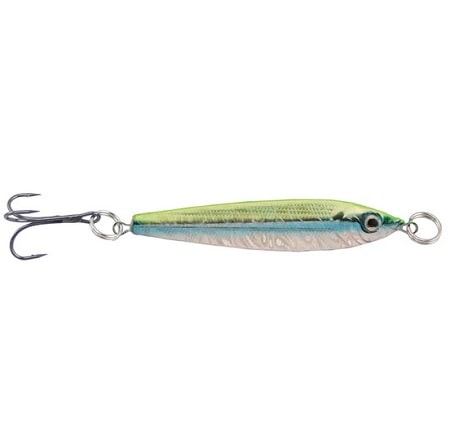
When it comes to catching salmon from the shoreline, beach, or pier, one lure stands out and this lure is the metal jig, which is the go-to lure for many anglers because these lures cast far and can get deep.
To optimize your fishing success, you’ll need to choose the right jig weight based on the water conditions in front of you.
Most beaches have a gradual slope, making a 1-ounce metal jig, such as the P-Line Laser Minnow, an excellent choice. This weight will allow for good casting distance, get your jig down into the strike zone, and reduce the risk of snagging on the bottom or gathering seaweed.
The P-Line Laser Minnow is an exceptional jigging lure designed with custom holographic laser tape, giving it a remarkably realistic and fish-attracting appearance. Its elongated shape ensures a highly erratic action, making it effective no matter how you jig it.
To begin, cast your metal jig as far as possible and then allow it to sink to your desired depth. Reel in the slack line, and then perform a pop with your rod, letting the jig sink and flutter down. Repeat this lifting and dropping motion. Salmon can bite on both the drop and the lift, so stay alert and be ready to set the hook if you sense any movement!
For anglers fishing from public fishing piers, heavier jigs like the Puget Pounder Jig are preferred. In this case, using a 1-ounce to 2.5-ounce jig will prove to be the winning ticket for landing those prized salmon.
Float Fishing With Herring From Shore
This fishing technique requires a bit more finesse than jigging. Herring is a delicate bait, and experienced anglers often brine their baits the night before to prolong their lifespan on the end of the line. Despite this extra step, float fishing with herring can be incredibly effective for beach fishing.
To get started, opt for a longer fishing rod, ideally in the 9’6″ to 11′ range with a softer action. The longer rod enable you to make long lob casts that ensures that you don’t accidentally rip the bait off as you attempt to cast it a considerable distance towards those elusive salmon.
Next, rig a big sliding float with the appropriate sinker size to achieve maximum casting distance. Attach a 3′ to 4′ leader of 25-pound test line to two 3/0 octopus hooks and rig your cut-plug herring bait. If there’s a current, you can let the bait sit out there, and it will actively spin as it pulls against the current, making it irresistible to Chinook and Coho salmon.
Use a good slip float to make it easier to cast and to set your desired depth which is often 10 to 17 feet deep.
One key component of all methods of salmon fishing is to ensure you are using the best hooks for salmon fishing. Good hooks will hook more salmon and will hold on longer.
Shore Fishing for Salmon with Fly Fishing
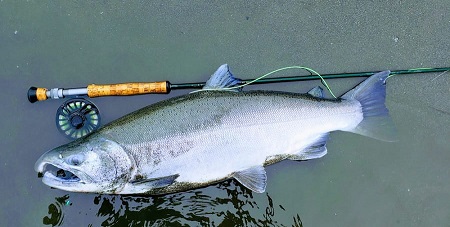
For those who prefer fly fishing, a 7 or 8-weight fly fishing rod should suffice for shore salmon fishing. This size fly rod is a bit heavy for Pinks but provides better casting distance and can handle larger species like Chinook salmon.
Your rod should be at least 9 feet long, and a fast-action blank is preferable for achieving the necessary casting distance. A floating line will suffice as the fishing depth is relatively shallow.
Effective shore salmon fishing flies mimic shrimp, crab larvae, minnows, sandlance, and needlefish. Streamers resembling baitfish are also great choices.
Timing and Seasonal Considerations
Timing is crucial for successful salmon fishing from shore. The fish are usually scattered in the vast ocean unless they are actively feeding in a specific area. You can start searching for salmon on the shorelines beside your local rivers a few weeks before they are expected to return to their natal streams.
Pink salmon are typically found from late July to early September, while coho salmon are present along shorelines and beaches in September and October.
However, there are exceptions, such as the early runs of the Capilano River stock which can be found along the shorelines of West Vancouver in July and August, or when Alaska Salmon Fishing since Alaska salmon tend to run much earlier.
Salmon Fishing From Shore At Night
Night fishing for salmon is a great time to fish salmon from shore since the salmon often move in closer to shore and closer to their spawning rivers under the cover of darkness. Many will also start their runs up the river in the dark.
I discuss night fishing tactics in my article Night Fishing For Salmon.
Fishing The Tides For More Salmon
Pay attention to the tide, as it plays a significant role in determining the best time for fishing. Fish tend to become active near the shore during tidal changes, and some locations yield excellent results during low tide, while others are more productive during high tide.
Regardless of the time of year or the salmon species you are fishing for, normally a higher tide is best for salmon fishing from shore. If I can plan my shore fishing trip around the tides, I’ll always fish the four-hour window around the high tide.
Show up two hours before high tide, and fish two to four hours afterward. The high tides seem to help push the fish to within casting distance from the shore.
Observing and Techniques for Shore Fishing for Salmon
Before casting, take a moment to observe your surroundings and look for signs of fish in the water. Pink salmon often reveal their dorsal fins above the water, while baitfish leaping out of the water indicates that salmon are feeding beneath the surface.
As for techniques, casting straight out and reeling in is the basic approach. Alternatively, you can cast and then move down the shoreline to cover more water. Moving slowly and exploring while covering water can help you locate more salmon.
Once you’ve cast your lure, start retrieving it immediately to keep it from sinking to the bottom. The retrieval speed is generally faster than in a river, as these salmon are aggressive feeders and won’t hesitate to chase down their prey. Regularly twitch and rip the lure to add more action, and be ready to strike as soon as you feel a bite.
A pair of waders is advisable when shore and beach fishing, as you may need to walk out from the shore to reach deeper spots. However, always be vigilant and watch for large waves approaching the shore to avoid any unexpected surprises.
Promising Fishing Locations
Salmon fishing from shore can be enjoyed near various towns along the East Coast of Vancouver Island, such as Port Hardy, Port McNeil, Campbell River, Puget Sound, and Qualicum Beach. On the Sunshine Coast, you’ll find opportunities between Sechelt and Gibson.
Productive shorelines are often found near streams where salmon are expected to return for spawning.
Before participating in this fishery, remember to obtain a valid saltwater fishing license and a salmon conservation stamp. Familiarize yourself with the regulations of the area you plan to fish in, including any gear restrictions and daily retention limits for salmon.
Summary
Shore fishing for salmon is an exhilarating experience that doesn’t require access to a boat. Whether you’re a novice or an intermediate angler, you can successfully target King salmon, pink salmon, and coho salmon from the shore using the right techniques, tackle, and timing.
Choose the appropriate fishing gear, including a long and versatile rod, a reel with sufficient line capacity, and effective lures or flies that mimic the salmon’s preferred prey. Pay attention to the season and timing, as well as the behaviors and feeding patterns of the fish.
Be observant before and during your fishing trip to increase your chances of locating salmon. Employ various techniques such as casting, retrieving, then casting again and moving down the shoreline to cover more water.
Remember to fish responsibly by adhering to local regulations and conservation practices. By doing so, you’ll enjoy a thrilling fishing experience and contribute to preserving these magnificent fish for generations to come.
Shore Fishing For Salmon Q&A
If you have a question or would like to share some tips and advice about shore fishing for salmon, let us know in the comment section below.
Tight Lines,
Graham
